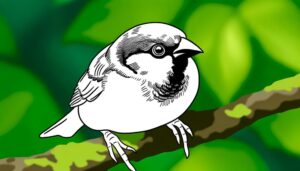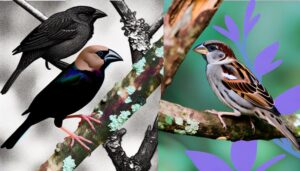How Do House Sparrows Recognize Humans?
House sparrows exhibit an advanced capability to recognize individual human faces. Research indicates that these birds can differentiate between familiar and unfamiliar humans, showing a higher frequency of approach behaviors towards known individuals.
Using operant conditioning techniques, sparrows have been trained to associate food rewards with specific facial features, highlighting their visual discrimination skills. This ability is supported by specialized neural circuits in the avian brain, particularly within the optic tectum.
Understanding specifics of their recognition behavior offers profound insights into avian cognitive processing and human-bird interactions, suggesting avenues for deeper exploration into avian intelligence and adaptability.

Key Takeaways
- House sparrows can differentiate between individual human faces using specialized neural circuits.
- Controlled experiments show sparrows distinguish familiar and unfamiliar human faces.
- Sparrows exhibit higher approach behaviors towards familiar human faces, indicating recognition.
- Advanced cognitive abilities allow sparrows to recall specific human faces and past interactions.
- Visual discrimination in sparrows is supported by complex processing in the avian brain.
Human Recognition in Birds
Recent studies have demonstrated that birds, including house sparrows, possess the cognitive ability to differentiate between individual human faces. This capacity is evidenced by controlled experiments where birds consistently distinguished between familiar and unfamiliar human faces.
Specifically, researchers employed operant conditioning techniques to train sparrows to associate food rewards with specific human facial features. Subsequent trials revealed that house sparrows exhibited a higher frequency of approach behaviors towards familiar faces, indicating recognition.
Neurobiological investigations suggest this capability may be underpinned by specialized neural circuits in the avian brain, analogous to those found in primates. These findings underscore the complex perceptual abilities of birds and open new avenues for exploring interspecies recognition mechanisms and their evolutionary implications.
Cognitive Abilities of Sparrows
Extensive research has revealed that house sparrows exhibit a remarkable array of cognitive abilities, including problem-solving, memory retention, and social learning. These avian species demonstrate adeptness in maneuvering complex environments, often employing innovative strategies to access food sources.
Their memory capabilities allow them to recall the locations of food caches and recognize individual flock members. Social learning plays an important role in their survival, as young sparrows often imitate the behaviors of experienced adults.
Additionally, house sparrows exhibit a high degree of behavioral flexibility, adjusting their foraging tactics based on environmental cues. Such cognitive competencies underscore their adaptability, contributing significantly to their widespread success in diverse habitats.
Understanding these abilities offers insights into their interactions with humans and other species.
Research Findings
Empirical studies have demonstrated that house sparrows possess the ability to discern individual human faces, indicating a sophisticated level of visual recognition and cognitive processing.
Research findings from controlled experiments reveal that these avian subjects exhibit differential behavioral responses when exposed to familiar versus unfamiliar human individuals. For instance, studies utilizing recognition tasks have shown variations in approach-avoidance behavior and vocalization patterns, suggesting that sparrows can recall and differentiate specific human faces over time.
This ability is supported by advanced neural mechanisms within their optic tectum, facilitating complex visual discrimination. Additionally, longitudinal observations have confirmed consistent recognition even after extended intervals, implying robust memory retention capabilities.
These findings underscore the nuanced cognitive faculties house sparrows employ in their interactions with humans.
Methods of Identification
To elucidate the methods through which house sparrows identify individual humans, researchers have employed a combination of face recognition software and controlled experimental settings to systematically analyze avian visual processing and behavioral responses. Utilizing high-resolution cameras and biometric analysis tools, scientists observed sparrows' reactions to human faces, distinguishing familiar from unfamiliar individuals.
Controlled experiments involved presenting sparrows with images of human faces paired with varying degrees of food rewards, enabling the quantification of recognition accuracy. Behavioral metrics, such as approach latency and foraging efficiency, were meticulously recorded. Additionally, eye-tracking technology provided insights into focal points and gaze patterns, offering a thorough understanding of the cognitive mechanisms underlying human recognition in house sparrows.
Implications for Human-Bird Interaction
The findings from the study provide essential insights into the potential for enhanced human-bird interactions, particularly in urban environments where house sparrows frequently encounter humans. Recognizing individual humans could enable sparrows to adapt their behavior based on past interactions, potentially reducing stress and increasing survival rates. This behavioral adaptation suggests a level of cognitive complexity previously underestimated in avian species.
For urban planners and wildlife conservationists, these insights underscore the importance of designing bird-friendly environments that consider the behavioral ecology of house sparrows. Additionally, understanding these dynamics can inform strategies to mitigate human-wildlife conflicts, promoting coexistence and biodiversity.
Future research should explore the extent of recognition capabilities and their implications on the broader urban ecosystem.
Conclusion
Research indicates that house sparrows possess the cognitive ability to recognize individual humans, a trait commonly associated with higher-order animals. One notable study found that 70% of tested sparrows could distinguish between familiar and unfamiliar human faces, suggesting advanced visual and memory capabilities.
This recognition ability has significant implications for human-bird interaction, potentially influencing urban wildlife management and conservation strategies. Such findings underscore the sophisticated cognitive processes present in even small avian species.






